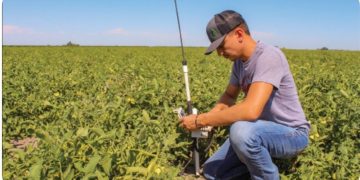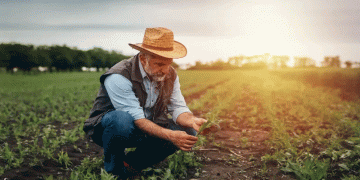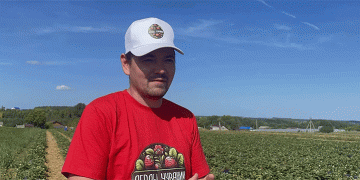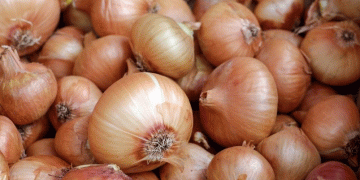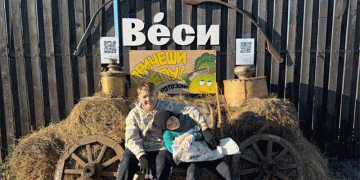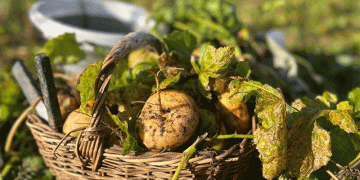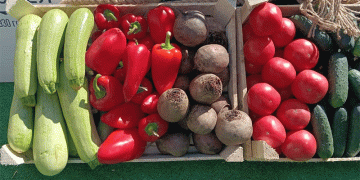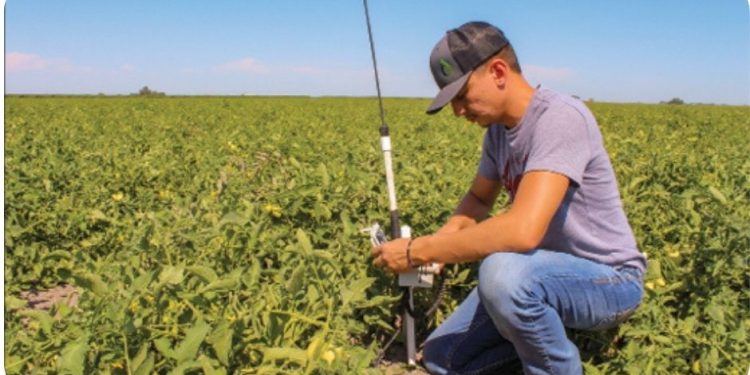Farmers and ranchers in the 21st century are increasingly turning to soil sensors, online data hubs and other advanced technologies designed to help them develop more precise uses of water and other inputs, and keep up with the paperwork.
None of this is possible, they say, without a good connection to the internet—something that can be dodgy in rural parts of the state. Only 46.5% of rural households in California can adopt broadband with download speeds of 100 megabits per second or faster, according to the 2020 Broadband Action Plan, produced by the California Broadband Council.
“Broadband and high-speed connectivity is that next era for the California farmer to maintain our competitive advantage,” said Robert Spiegel, a California Farm Bureau policy advocate.
The issue took on new importance with the COVID-19 pandemic, which forced much of the world online.
“COVID highlighted it for the importance for business operations,” said Cannon Michael, who runs Bowles Farming Co. in Los Banos. Michael named “consistency of service” as a top issue.
“It’s a wireless connection that’s beamed from several different towers to our tower,” Michael said of his digital access. “You get a little bit of spottiness, so it’s a little inconsistent, but it’s been getting better.”
Lalo Garcia, who handles technology at Bowles Farming, said one of his broadband-reliant projects involves soil sensors in fields, which record water and temperature data and help the farm make irrigation decisions. The farm also uses an app that allows an agronomist to send details of applications of crop-protection materials to an employee’s phone.
“The worker receives it and completes the action, and all that goes to the office where they keep track of it for the county,” Garcia said.
It wasn’t just business operations that were affected. Michael said his farm has housing for employees and their families.
“A lot of the kids, obviously, were at home,” Michael said. “We partnered with the provider that we are using, and we paid for the cost to get them service. They were trying to do stuff off of cellphones.”
In Monterey County, Mauricio Flores, production technology coordinator at Braga Fresh, said his farm has several technological programs in place that rely, at least some extent, on a good connection. One is HeavyConnect, which allows managers and employees to file reports pertaining to food safety, planting, inspections and other operations from the field.
“Whatever is input into HeavyConnect stays on your phone until you get to a reliable source of internet, that being either a good connection or Wi-Fi,” Flores said. “Once you get to any of those locations, then it automatically updates for us.”
Farm-machinery operators also are encouraged to use the app to report issues with the equipment, Flores added.
“It allows the people at the shop to see the reports that are being created in real time,” Flores said. “That way they can get to fixing them as fast as possible, instead of waiting for them to bring in the machinery.”
Flores said the farm also has a tracking app that allows the operation to keep tabs on field work done by the machinery and its operators.
“We need a good service for that one,” Flores said. “When the tracking system is working, it’s telling us how much time was spent out in the field. If we have spotty service or no service at all, then we’re not getting accurate information.”
Efforts are underway to help bring better broadband access to rural areas. The proposed state budget for fiscal year 2022 includes $6 billion to $7 billion for rural-broadband investment. Though some details remain to be worked out, about $3.75 billion will go to “middle mile” projects and an additional $2 billion is allocated to “last mile” work, Spiegel said.
“The way to look at it is, you have the urban core, but when you get out to rural communities, you truly need a hub,” Spiegel said. “That hub then becomes that middle-mile connector to the last mile.”
Identifying potential hubs is the aim of Senate Bill 28 by Sen. Anna Caballero, D-Salinas, which is pending in the Assembly.
Taylor Roschen, a Farm Bureau policy advocate, likened the system to roads, with the state highways as the middle mile and local or county roads as the last mile to the farm.
“I think the administration’s proposal is to use that middle mile as sort of like an open source,” Roschen said. “Because the fiber optic cables are being laid by the state, and the costs are borne by the state or the federal government, the providers don’t have to pay those costs. It will be like an open access for any provider that wants to utilize that network.”
The last mile, she added, will take more of a grant-based approach, with the message to providers and others being “if you want to come match funds with us to build out that last mile and connect to the middle mile, then we’ll help you get there.”
“Farm Bureau has always articulated a concern about rural connectivity for decades,” Roschen said, adding that the pandemic provided a new opportunity to raise the same points “and to amplify them in different contexts.”
At the federal level, two bills in Congress seek to improve rural Americans’ access to broadband. One, the Eliminating Barriers to Rural Internet Development Grant Eligibility Act, or EBRIDGE, would allow for public-private partnerships and give communities flexibility to comply with funding-match requirements. The other, the Broadband for Rural America Act, would authorize more than $7 billion for U.S. Department of Agriculture programs such as ReConnect, which awards grants and loans to facilitate broadband deployment.
Sara Arsenault, California Farm Bureau’s federal policy director, said Farm Bureau supports both bills and is active in a pair of coalitions working toward better broadband access: the American Connection Project Policy Coalition and Connect Americans Now.
Spiegel said the pandemic provided an opportunity for broadband challenges “to be very well known,” and the implications are wide-ranging.
“To respond to the wildfire crisis and the energy crisis, you need to have those real-time updates about what happens,” Spiegel said.
In agriculture, he added, “you need to know the real-time inputs of what it is that you have on farm to be able to meet the challenges brought about by climate change or water availability, or a lack of labor. Now is the moment that we have to ensure that rural California is not left behind and remains competitive with the rest of the state.”
– Kevin Hecteman, California Farm Bureau
Lalo Garcia looks over a soil sensor in a field planted to organic processing tomatoes near Los Banos. Garcia’s employer, Bowles Farming Co., is among the agricultural operations that rely heavily on sensors and online data portals – and therefore on good broadband connections. Photo: Kevin Hecteman
